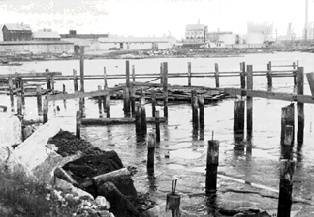Hunters Point Mid-1990s: Difference between revisions
m (1 revision(s)) |
(addition of categories, photo credits) |
||
| Line 3: | Line 3: | ||
'''3rd & Evans, in the heart of today's Bayview neighborhood, was a brackish marsh and home to SF's second "butchertown" until it was filled in the post-WWII era.''' | '''3rd & Evans, in the heart of today's Bayview neighborhood, was a brackish marsh and home to SF's second "butchertown" until it was filled in the post-WWII era.''' | ||
''photo: San Francisco History Center, San Francisco Public Library'' | |||
[[Image:bayvwhp$butchertown-wetlands.jpg]] | |||
'''Butchertown wetlands''' [[The First Grab | Cows? In SF?]] | |||
'' | ''photo: San Francisco History Center, San Francisco Public Library'' | ||
In the southeastern neighborhood of Hunters Point, neighbors organized in the Morgan Hill Resident Association are combatting a plan to build a third power plant in the area (PG&E already has two coal-fired plants along the bayshore nearby). Charges of environmental racism have beset the proposal, since the Bayview/Hunter's Point neighborhood, a largely African-American neighborhood, is already home to several dozen known toxic sites, many residents complain of respiratory problems and strange cancers, and no one is proposing placing power plants in other neighborhoods in San Francisco. Supervisor Terence Hallinan stated in a public hearing that of the five major sources of acid rain in the Bay Area, two are in Bayview/Hunter's Point. (''S.F. Chronicle ''2/13/95) | |||
The Hunters Point Naval Shipyard, due for decommissioning, has undergone a year-long community process of planning for its reclamation and re-use. The latest tenant to move in and try to save its historic use as a shipyard is Astoria Metals, which is planning to rebuild old battleships into floating power plants for use in underdeveloped countries. The plan, costing $20 million, will take three years, and gives city planners and neighborhood activists hope that the maritime use of the historic 550-acre site can be preserved. Astoria's tenancy was ended under a cloud, with numerous charges of toxic discharge violations pending. The military's toxic residue, however, will take until 2007 to completely decontaminate. | |||
In May, 1995, a controversy erupted over conflicting plans for 30 acres atop Bayview Hill, which looms over Candlestick. The land's owner, a Bayview native who inherited the land from her deceased husband, wants to build housing on her land, but the Recreation and Park Department has designated the land for acquisition under San Francisco's Open Space development program. It is expected that the land will be purchased through negotiation or eminent domain and will become a new park for the area (though in fact it has remained open and undeveloped all along). | |||
''--Chris Carlsson, 1996'' | |||
'' | |||
[[Candlestick view | Prev. Document]] [[Before the Navy, Hunters Point was home to a Chinese shrimping village. In 1938 the Fire Department burned the remaining structures to make way for the Navy. In 1941, the 250-foot tall Avisadero Point at the very eastern end of the Point was dynamited and turned into landfill | Next Document]] | |||
[[ | [[category:Bayview/Hunter's Point]] [[category:Ecology]] [[category:Water]] [[category:1930s]] [[category:African-American]] [[category:1990s]] | ||
Revision as of 00:05, 17 August 2008
File:Bayvwhp$butchertown-1930s.jpg
3rd & Evans, in the heart of today's Bayview neighborhood, was a brackish marsh and home to SF's second "butchertown" until it was filled in the post-WWII era.
photo: San Francisco History Center, San Francisco Public Library
Butchertown wetlands Cows? In SF?
photo: San Francisco History Center, San Francisco Public Library
In the southeastern neighborhood of Hunters Point, neighbors organized in the Morgan Hill Resident Association are combatting a plan to build a third power plant in the area (PG&E already has two coal-fired plants along the bayshore nearby). Charges of environmental racism have beset the proposal, since the Bayview/Hunter's Point neighborhood, a largely African-American neighborhood, is already home to several dozen known toxic sites, many residents complain of respiratory problems and strange cancers, and no one is proposing placing power plants in other neighborhoods in San Francisco. Supervisor Terence Hallinan stated in a public hearing that of the five major sources of acid rain in the Bay Area, two are in Bayview/Hunter's Point. (S.F. Chronicle 2/13/95)
The Hunters Point Naval Shipyard, due for decommissioning, has undergone a year-long community process of planning for its reclamation and re-use. The latest tenant to move in and try to save its historic use as a shipyard is Astoria Metals, which is planning to rebuild old battleships into floating power plants for use in underdeveloped countries. The plan, costing $20 million, will take three years, and gives city planners and neighborhood activists hope that the maritime use of the historic 550-acre site can be preserved. Astoria's tenancy was ended under a cloud, with numerous charges of toxic discharge violations pending. The military's toxic residue, however, will take until 2007 to completely decontaminate.
In May, 1995, a controversy erupted over conflicting plans for 30 acres atop Bayview Hill, which looms over Candlestick. The land's owner, a Bayview native who inherited the land from her deceased husband, wants to build housing on her land, but the Recreation and Park Department has designated the land for acquisition under San Francisco's Open Space development program. It is expected that the land will be purchased through negotiation or eminent domain and will become a new park for the area (though in fact it has remained open and undeveloped all along).
--Chris Carlsson, 1996
Prev. Document [[Before the Navy, Hunters Point was home to a Chinese shrimping village. In 1938 the Fire Department burned the remaining structures to make way for the Navy. In 1941, the 250-foot tall Avisadero Point at the very eastern end of the Point was dynamited and turned into landfill | Next Document]]

